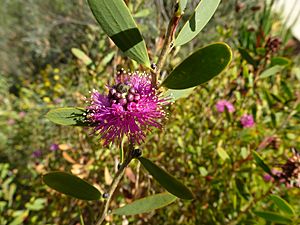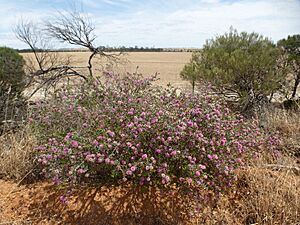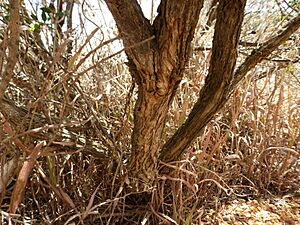Melaleuca conothamnoides facts for kids
Quick facts for kids Melaleuca conothamnoides |
|
|---|---|
 |
|
| M. conothamnoides foliage and flowers | |
| Scientific classification | |
| Genus: |
Melaleuca
|
| Species: |
conothamnoides
|
Melaleuca conothamnoides is a cool shrub that belongs to the Myrtaceae family, also known as the myrtle family. You can only find this plant growing naturally in the south-west part of Western Australia. It's special because of its fairly big leaves, tiny bumps that hold oil, and unique leaf-like parts (called bracts) that cover its flower buds before they bloom.
Contents
About the Melaleuca conothamnoides Plant
Melaleuca conothamnoides is a woody shrub with many branches. It usually grows to be about 1.5 meters (5 feet) tall and 1 meter (3 feet) wide. Its leaves are arranged one after another along the stem. They are shaped like a spear (lance-shaped), an oval (oblong), or a flattened circle (elliptic).
Most leaves are about 24 to 45 millimeters (1 to 2 inches) long. They are also 4 to 11 millimeters (0.2 to 0.4 inches) wide. You can often see small, clear bumps on the leaves. These are oil glands that hold the plant's natural oils. The leaves also have 3 to 5 veins running side-by-side.
Flowers and Fruit
The flowers of this plant grow in groups or short spikes. You'll mostly find them at the ends of the branches. These branches keep growing even after the flowers bloom. Sometimes, flowers also appear where the upper leaves meet the stem (called the leaf axil).
Each flower group has 8 to 15 sets of three flowers. These groups can be up to 35 millimeters (1.4 inches) across. Before the flowers open, they are covered by greenish-black, overlapping leaf-like parts called bracts. The petals are small, about 2 to 4 millimeters (0.08 to 0.16 inches) long. They fall off as the flowers open up.
The flowers have five bundles of stamens, which are the parts that make pollen. Each bundle has 7 to 9 purple or pinkish-mauve stamens. The main time for flowering is from September to November. However, flowers have been seen as early as August and as late as January. After the flowers finish blooming, the plant grows fruit. These fruits are woody, round, or oval-shaped capsules that grow in clusters.

How It Got Its Name
This plant was first officially described in 1964. A scientist named Charles Austin Gardner wrote about it in a science journal. He found the first plant specimen himself near Tammin, in a sandy, gravelly area.
The second part of its scientific name, conothamnoides, tells us something interesting. It means "resembling Conothamnus". The ending -oides is a Latin word part that means "looking like" or "having the form of". So, the plant was named because it looks similar to another plant in the Conothamnus genus.
Where Melaleuca conothamnoides Lives
This type of melaleuca plant mainly grows in sandy and gravelly soils. You can find it in the drier wheatbelt region of Western Australia. Its home stretches between the towns of Tammin and Morawa.
It lives in several different natural areas, including the Avon Wheatbelt, Coolgardie, Geraldton Sandplains, Jarrah Forest, Murchison, and Yalgoo biogeographic regions.
Conservation Status
The good news is that Melaleuca conothamnoides is not considered to be in danger. The Government of Western Australia Department of Parks and Wildlife lists it as "not threatened." This means there are enough of these plants in the wild, and they are not at risk of disappearing.


